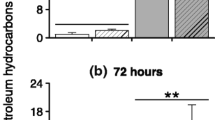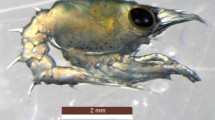Abstract
The effects of two oil dispersants (Vecom B-1425 GL and Norchem OSD-570) mixed with diesel oil on the survival and behaviour of the stage II nauplii of the barnacle Balanus amphitrite were investigated. The24 and 48-hour LC50 values for Vecom B-1425 GL:diesel mixture were 514 and 48 mg l−1 respectively, while respective values for Norchem OSD-570:diesel mixture were 505 and 71 mg l−1. Under sublethal concentrations, increased levels of the dispersant:diesel mixtures caused a reduction in phototactic responses. Balanus amphitrite nauplii failed to exhibit phototactic responses when exposed to Vecom B-1425GL:diesel mixtures of 400 mg l−1 and higher for 24 hours. A longer exposure time of 48 hours further reduced the Lowest Observable Effect Concentrations (LOECs) to 60 mg l−1. The LOECs for Norchem OSD-570:diesel mixtures under exposure periods of 24 and 48 hours were 400and 80 mgl−1 respectively. The curvilinear velocities (VCL) and straight-line velocities (VSL) of the stage II nauplii ranged from 0.7–1.1and 0.2-0.4 mms−1 respectively. Increased concentrations of dispersant:diesel mixtures caused a significant change in the curvilinear and straight-line velocities. Both oil dispersants, dispersant:diesel mixtures of 20 to 40 mgl−1 caused significant increases in VCL, but no significant change in VSL. Dispersant:diesel mixtures of 100 mg l−1 and higher resulted in a reduction in VSL for both dispersants.
Similar content being viewed by others
References
Abel, P. D., 1974. Toxicity of synthetic detergents to fish and aquatic invertebrates. J. Fish. Biol. 6: 279–298.
Budworth, P. R., R. P. Mann & P. L. Chapman, 1988. Relationships between computer measurements of motion of frozen-thawed bull spermatozoa and fertility. J. androl. 9: 41–54.
Connor, P. M., 1972. Acute toxicity of heavy metals to some marine larvae. Mar. Pollut. Bull. 5: 171–174.
Dirnberger, J. M., 1993. Dispersal of larvae with a short planktonic phase in the polychaete Spirorbis spirillum(Linnaeus). Bull. mar. Sci. 52: 898–910.
Environmental Protection Department (EPD), 1993. Environment Hong Kong 1993. Hong Kong Government, 183 pp.
Fisher, W. S. & S. S. Foss, 1993. A simple test for toxicity of number 2 fuel oil and oil dispersants to embryos of grass shrimp, Palaemonetes Pugio. Mar. Pollut. Bull. 26: 385–391.
Forward, R. B., Jr. & W. F. Hettler, Jr., 1992. Effects of feeding an predator exposure on photoresponses during diel vertical migration of brine shrimp larvae. Limnol. Oceanogr. 37: 1261–1270.
Foster, B. A., 1982. Hong Kong Barnacles. In Morton, B. S. & C. K. Tseng (eds), Proceedings of the First International Marine Biological Workshop: The Marine Flora and Fauna of Hong Kong and Southern China, Hong Kong, 1980. Hong Kong University Press, Hong Kong: 207–232.
Fry, J. C., 1993. Biological data analysis. IRL Press, Oxford University Press, Oxford, 418 pp.
Howarth, R. W., 1989. Determining the ecological effects of oil pollution in marine ecosystems. In Levin, S. A., M. A. Harwell, J. R. Kelly & K. D. Kimball (eds), Ecotoxicology: Problems and Approaches. Springer-Verlag, New York: 69–97.
Hurlbut, C. J., 1993. The adaptive value of larval behavior of a colonial ascidian. Mar. Biol. 115: 253–262.
Lang, W. H., D. C. Miller, P. J. Ritacco & M. Marcy, 1981. The effects of copper and cadmium on the behaviour and development of barnacle larvae. In Vernberg, F. J., A. Calabrese, F. Thurberg & W. B. Vernberg (eds), Biological Monitoring of Marine Pollutants. Academic Press, New York: 165–203.
Lewis, M. A., 1990. Chronic toxicities of surfactants and detergent builders to algae: a review and risk assessment. Ecotoxicol. environ. Safety 20: 123–140.
Lewis, M. A., 1991. Chronic and sublethal toxicities of surfactants to freshwater and marine animals: a review and risk assessment. Wat. Res. 25: 101–113.
Lewis, M. A., 1992. The effects of mixtures and other environmental modifying factors on the toxicities of surfactants to freshwater and marine life. Wat. Res. 26: 1013–1023.
Marsden, J. R., 1990. Light responses of the planktonic larva of the serpulid polychaete Spirobranchus polycerus. Mar. Ecol. Prog. Ser. 58: 225–233.
Nagell, B., M. Notini & O. Grahn, 1974. Toxicity of four oil dispersants to some animals from Baltic sea. Mar. Biol. 28: 237–243.
Nuwayhid, M. A., S. P. Davies & H. Y. Elder, 1980. Changes in the ultrastructure of the gill epithelium of Patella vulgataafter exposure to North Sea crude oil and dispersants. J. mar. Biol. Ass. U.K. 60: 439–448.
Portmann, J. E. & P. M. Connor, 1968. The toxicity of several oilspill removers to some species of fish and shellfish. Mar. Biol. 1: 322–329.
Ordzie, C. J. & G. C. Garofalo, 1981. Lethal and sublethal effects of short term acute doses of Kuwait crude oil and a dispersant Corexit 9527 on bay scallop, Argopectin irradians(Lamarck) and two predators at different temperatures. Mar. environ. Res. 5: 195–211.
Singer, M. M., D. L. Smalheer, R. S. Tjeerdema & M. Martin, 1990. Toxicity of an oil dispersant to the early life stages of four California marine species. Envir. Toxicol. Chem. 9: 1387–1395.
Sprague, J. B., J. H. Vandermeulen & P. G. Wells, 1981. Oil and dispersants in Canadian seas–recommendations from a research appraisal. Mar. Pollut. Bull. 12: 45–46.
Stearns, D. E. & R. B. Forward Jr., 1984. Photosensitivity of the calanoid copepod Acartia tonsa. Mar. Biol. 82: 85–89.
Svane, I. & C. M. Young, 1989. The ecology and behaviour of ascidian larvae. Oceanogr. mar. biol. Ann. Rev. 27: 45–90.
Swedmark, M., B. Braaten, E. Emanuelsson & A. Granmo, 1971. Biological effects of surface active agents on marine animals. Mar. Biol. 9: 183–201.
Thompson, G. B. & R. S. S. Wu, 1981. Toxicity testing of oil slick dispersants in Hong Kong. Mar. Pollut. Bull. 12: 233–237.
Thorson, G., 1964. Light as an ecological factor in the dispersal and settlement of larvae of marine bottom invertebrates. Ophelia 1: 167–208.
Wu, R. S. S., 1988. Marine pollution in Hong Kong: a review. Asian mar. Biol. 5: 1–23.
Wu, R. S. S. & C. D. Levings, 1978. An energy budget for individual barnacles (Balanus glandulaDarwin). Mar. Biol. 45: 225–235.
Zar, J. H., 1984. Biostatistical analysis (2nd edn.) Prentice-Hall International, New Jersey, 718 pp.
Author information
Authors and Affiliations
Corresponding author
Rights and permissions
About this article
Cite this article
Wu, R.S.S., Lam, P.K.S. & Zhou, B.S. Effects of two oil dispersants on phototaxis and swimming behaviour of barnacle larvae. Hydrobiologia 352, 9–16 (1997). https://doi.org/10.1023/A:1003024500609
Issue Date:
DOI: https://doi.org/10.1023/A:1003024500609




